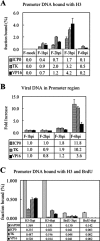Temporal association of the herpes simplex virus genome with histone proteins during a lytic infection
- PMID: 18160436
- PMCID: PMC2268451
- DOI: 10.1128/JVI.00586-07
Temporal association of the herpes simplex virus genome with histone proteins during a lytic infection
Abstract
Previous work has determined that there are nucleosomes on the herpes simplex virus (HSV) genome during a lytic infection but that they are not arranged in an equally spaced array like in cellular DNA. However, like in cellular DNA, the promoter regions of several viral genes have been shown to be associated with nucleosomes containing modified histone proteins that are generally found associated with actively transcribed genes. Furthermore, it has been found that the association of modified histones with the HSV genome can be detected at the earliest times postinfection (1 h postinfection) and increases up to 3 h postinfection. However from 3 h to 6 h postinfection (the late phase of the replication cycle), the association decreases. In this study we have examined histone association with promoter regions of all kinetic classes of genes. This was done over the time course of an infection in Sy5y cells using sucrose gradient sedimentation, bromodeoxyuridine labeling, chromatin immunoprecipitation assays, Western blot analysis, trypsin and DNase digestion, and quantitative real-time PCR. Because no histones were detected inside HSV type 1 capsids, the viral genome probably starts to associate with histones after being transported from infecting virions into the host nucleus. Promoter regions of all gene classes (immediate early, early, and late) bind with histone proteins at the start of viral gene expression. However, after viral DNA replication initiates, histones appear not to associate with newly synthesized viral genomes.
Figures





References
-
- Berger, S. L. 2002. Histone modifications in transcriptional regulation. Curr. Opin. Genet. Dev. 12142-148. - PubMed
Publication types
MeSH terms
Substances
Grants and funding
LinkOut - more resources
Full Text Sources

